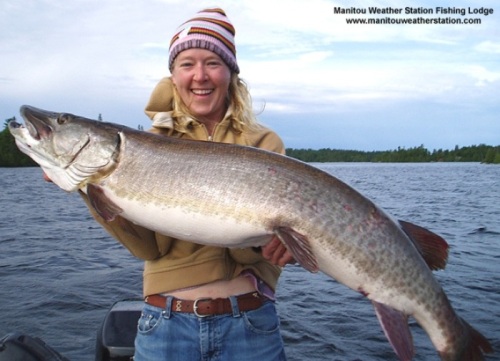
Muskellunges and Friends
Muskellunges are usually ecologically
misunderstood organisms. Some anglers assume Muskellunges eat every
other organism in the ecosystem, however this is not true for
several reasons. The first, and most important, is that Muskellunges
are very rare in lakes and rivers. They are very territorial animals
and do not like to infringe on each other's space. For this reason,
Muskellunges do not suppress prey population. The typical boom-bust
growth curves in predator/prey relations do not really apply to
Muskellunges, although they are excellent predators. The fact of the
matter is that their population in any one ecosystem is not
significant to drastically affect their prey. However the rumors are
true, Muskellunges are mostly know as sift predators--which they
are. They feed on a variety of other species, sometimes as bizarre
as
cats or
dogs, however in regard to
Northern Pike, they are relatively selective eaters.
like to infringe on each other's space. For this reason,
Muskellunges do not suppress prey population. The typical boom-bust
growth curves in predator/prey relations do not really apply to
Muskellunges, although they are excellent predators. The fact of the
matter is that their population in any one ecosystem is not
significant to drastically affect their prey. However the rumors are
true, Muskellunges are mostly know as sift predators--which they
are. They feed on a variety of other species, sometimes as bizarre
as
cats or
dogs, however in regard to
Northern Pike, they are relatively selective eaters.
But, Muskellunges don't just dominate their ecosystem; they
also have several organism to watch out for. In a Muskellunge's
life, like most organisms, it is most vulnerable shortly after
birth. This is because of the close relative,
Esox lucius,
and their spawning time. Esox lucius usually spawn
about 2 weeks before Muskellunges. Therefore, when a Northern Pike's jaws are developed (around the second week of
maturation) they are ready to begin predation of Muskellunges. In these vulnerable times, Muskellunges often fall victim to
Esox lucius predation. However, Muskellunge's also have an
enemy to watch out for, for more information please visit
http://www.recipezaar.com/Baked-Muskellunge-Muskie-Musky-227628. Another harmful interaction between
Muskellunge and another organism is the virus that causes Lymphosarcoma. There is
very little known about the infection and its
origin is still being researched. The symptoms are a golf ball
sized, red bump on the side of the Muskellunge. The disease is most
commonly contracted around the time of spawning. It is believed to
be this time because the infection spreads from skin to skin
contact. The disease is more common in cooler waters, however it has
been found in various temperatures. Due to the lack of knowledge of
the virus, consumption of Escoids with this is disease is highly
discouraged. A parasite Escoids have to watch out for is
Diphyllobothrium spp. This tapeworm is around 1 inch in length
and lives in the muscles of Escoids, and other fish species.
However, if ingested by a human the worm can grow in the stomach.
The symptoms usually include nausea and dizziness. A 'new' parasite
to Escoids is
Heterosporis sp.; it usually infects yellow perch and has actually began to infect Escoids .
The muscles of infected fish appear white. Another parasite of
Escoids is a larval roundworm which forms golden brown cysts on the
organs of fish. This organisms may be able to ride the biological
magnification title wave into humans, so consumption is highly
discouraged.
 For other sweet info,
click here.
For other sweet info,
click here.